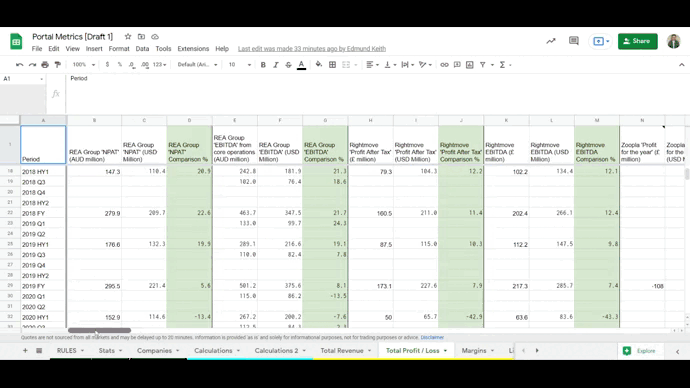In the grand spectrum of exciting industries, real estate portals are somewhere in the middle between packaging materials and lion-taming.
While most people enjoy browsing properties on them, it would be fair to say that not everyone gets a kick out of reading about their financial results or who their new head of marketing is.
The stories I write about real estate portal companies for OnlineMarketplaces.com are certainly esoteric then, or at least they would be considered niche – there is a limited but high-value audience for this stuff.
Just because the subject matter isn’t for everyone doesn’t mean the writing needs to be.
And just because you already have a loyal readership doesn’t mean that you shouldn’t be trying to expand the audience you get from search engines.
These are a few lessons I’ve learned to make things more interesting in two and a half years of creating content for a niche industry.
Expertise Comes From Data, Not Big Words
-
Image by author, September 2022

The squinting was worth it for all the lovely data.
I know or have interacted personally with a high percentage of my audience at one time or another, so why would my tone be impersonal and stiff when writing for them?
Too often, I come across industry press that reads like an undergraduate’s dissertation.
On the other hand, I am writing about an industry where some companies are described as “500-pound gorillas” and where a market downturn can lead me to use the word “trillion” next to the word “dollars.”
The numbers and quotes your content needs will be out there somewhere.
Your readership and the search engines will appreciate you taking the time to dig around the internet to find and present them without the needlessly big words.
At the start of this year, I spent two hours at the end of every day finding the financial and operational metrics for all publicly traded real estate portal companies worldwide for the last four years.
Incredibly tedious work, no doubt, but it’s a unique set of data that allowed me to show expertise as someone who is still relatively new to a high-value industry.
SEO benefits of combining “need to know, hard to find” data with a less formal tone:
- It allows you to show expertise, especially if you are new to the niche.
- Addressing your readers informally can help build community and repeat engagement, especially if combined with a personalized newsletter.
- Collecting stats is the first step toward building graphs and visuals.
Avoid Numbers In A Paragraph. It’s All About Visuals
If you’ve taken the time to get the “need to know, hard to find” data, don’t waste it by just writing numbers in a paragraph.
When I had to read industry news in a previous job, I ignored numbers in a paragraph.
One of the biggest (and, on reflection, most apparent) lessons from my last two-and-a-half years of telling people about property portal performance is: Neither does anyone else.
It’s not just the subconscious, lizard-brain stuff about humans preferring to look at images than text – graphs help readers contextualize numbers instantly and boost engagement rate.
-
 Image from OnlineMarketplaces.com, September 2022
Image from OnlineMarketplaces.com, September 2022
If you can’t be bothered making a graphic, maybe the numbers aren’t worth including.
We found that our articles with at least one graph have a 34% better session duration than those that are just plain text.
It might take longer and mean learning to use Photoshop, but using data in some good quality images with proper alt attribution will go a long way with search engines. It can be the difference between the #2 blue link and the featured snippet.
SEO benefits of taking the time to build graphs and visual resources:
- Users will stay on your page if they have some eye candy.
- If you give them relevant titles and Alt attribution, Google will index your graphs and images, and you’ll see a traffic boost from Google Image search.
Word of warning here. We used a plugin that rendered all our graphs using Javascript. That meant Google wasn’t indexing them as images, and they were slowing our pages down.
There are a lot of plugins out there that make nice-looking graphs. You might want to use one to build graphs in the back end and then use a screenshot image on the front end.
Opinions Make For Lively Content And Can Lead To Links
Good creators read a lot, and they replicate what engages them.
I try to read a lot outside of my industry and have a board where I keep any niche content I particularly enjoy. Most of the articles on that board take a side and advocate for something.
Invariably, a writer’s subtle expression of their opinion makes for more engaging copy.
My boss, for example, has a lot of opinions about our niche.
I recorded one of our conversations and put it on YouTube – it generated a lot of feedback and led to a counter-argument interview with another industry notable.
If your opinion is contrived, aimed at selling something, and not sustained throughout your work, you might as well not bother.
I have another board named “How not to write.”
Five out of the first ten entries have been put in there to express the incredibly bland opinion that “PropTech is the future of the property industry” – an opinion that is probably aimed at selling something.
Maybe you want to see more equality in your niche. Perhaps you want to see faster adoption of technology, or, like some people in my niche, you are strongly anti-monopoly.
Whatever your position, express it consistently, carefully, and preferably with some humor, and you’ll have people asking you to repeat it on their blog, podcast, or social media.
SEO benefits of lacing your niche content with some subtle opinions:
- When expressed consistently and appropriately, opinions can lead to content collaboration opportunities.
- Opinions make your content lively, build community, and increase engagement.
Pro tip: The trick here is to know the time and place for a sprinkling of opinion. Don’t let your opinions define your publication!
Keep Detailed Records Of Your Output, Analyze It, Adjust It, and Repeat
The data I’ve collected from our site over the last two-and-a-half years shows that when it comes to the types of news articles we cover, there is an almost inverse relationship between Google traffic and how much companies want you to write them up.
Stories about M&A do well, as do any stories about redundancies or controversy. Stories based on straight-laced company press releases about a new product or partnership do poorly.
-
 Image by author, September 2022
Image by author, September 2022
Not all news is created equal. Word count, category, day of the week, number of visuals, companies mentioned, where you shared it, who amplified – it’s all data you should be recording and analyzing.
I might get a few groans from freelancers I work with when I ask them to fill in all the information, but that data tells me what works and what doesn’t.
SEO benefits of keeping detailed records of your content output:
- GA (Google Analytics) is great, but there’s plenty it can’t tell you.
- The more data you have on your content, the quicker you can create a feedback loop that tells you exactly what Google sees your site as an authority on.
Longer, More In-depth Content Is Worth The Effort
Over 90% of content receives zero traffic from Google. That is to say, for most people, a tiny percentage of their content does a huge portion of the heavy lifting.
The stats bear out! Almost 75% of our pageviews over the last two-and-a-half years have come from the top 25 articles, meaning that I initially wasted a lot of time writing up news stories that very few people read.
 Image by author, September 2022
Image by author, September 2022
The lesson here is that if you cover a niche industry, you are automatically well within the top 1% of people who most care about this stuff. If you, as a one-percenter, find something boring, it is almost certainly boring and not worth your time writing up.
Two years ago, I was grateful when PR people came to me with press releases, which meant I didn’t have to search for news. I’m now much pickier about what I will and won’t bother spending time writing up.
Go and do some research on something interesting instead.
Spend time making something the best resource on the internet rather than being the first to press about something very few people will care about.
SEO benefits of leaning into industry-specific long-form content:
- Longer form content is more likely to be considered ‘helpful’ by Google.
- Fewer short articles mean less content you have to maintain and an optimized crawl budget.
- Longer form content lends itself to being updated periodically – a great, low-effort tactic.
Have fun creating great content for that niche of yours!
More resources:
Featured Image: pikselstock/Shutterstock
window.addEventListener( ‘load’, function() {
setTimeout(function(){ striggerEvent( ‘load2’ ); }, 2000);
});
window.addEventListener( ‘load2’, function() {
if( sopp != ‘yes’ && addtl_consent != ‘1~’ && !ss_u ){
!function(f,b,e,v,n,t,s)
{if(f.fbq)return;n=f.fbq=function(){n.callMethod?
n.callMethod.apply(n,arguments):n.queue.push(arguments)};
if(!f._fbq)f._fbq=n;n.push=n;n.loaded=!0;n.version=’2.0′;
n.queue=[];t=b.createElement(e);t.async=!0;
t.src=v;s=b.getElementsByTagName(e)[0];
s.parentNode.insertBefore(t,s)}(window,document,’script’,
‘https://connect.facebook.net/en_US/fbevents.js’);
if( typeof sopp !== “undefined” && sopp === ‘yes’ ){
fbq(‘dataProcessingOptions’, [‘LDU’], 1, 1000);
}else{
fbq(‘dataProcessingOptions’, []);
}
fbq(‘init’, ‘1321385257908563’);
fbq(‘track’, ‘PageView’);
fbq(‘trackSingle’, ‘1321385257908563’, ‘ViewContent’, {
content_name: ‘niche-content-lessons’,
content_category: ‘creation vertical-seo’
});
}
});


